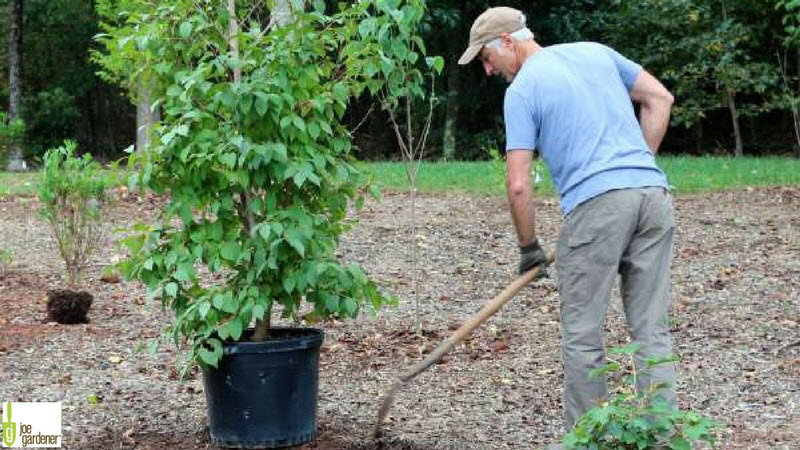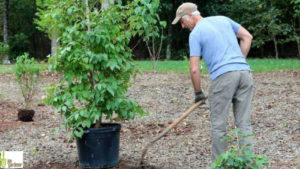What’s New with Tree Planting
By Thomas Christopher
If you are contemplating adding a tree to your garden or yard, do it now — early to mid-fall, as well as spring, are the best seasons for planting trees and shrubs. And if you do so, do it right. For there’s new research that demonstrates that old accepted methods for tree planting were sometimes misguided.
This news comes from Dr. Linda Chalker-Scott, an Extension Specialist in Urban Horticulture at Washington State University. It stems from her experience as a consultant; she is, she says, frequently called in to assess why a tree planting has failed. This is all too common an event, she reports, even in the benevolent conditions of the Pacific Northwest. In short, she has done a lot of what she describes as “horticultural CSI”
What she found in examining tree planting failures is that all too often the fatal problem lay in the roots. Three conditions were particularly common. Either the tree was planted too deeply so that the roots suffocated, or the roots grew in a circle around the tree, gradually girdling it, or else roots never grew out into surrounding soil from their original ball.
The first two of these problems were a result of how the tree was grown and presented to the customer. The circling roots, in particular, are a result of the new practice of growing, or at least starting, nearly all trees in containers. When grown in pots, the tree seedling’s roots reach out only to be blocked by the wall of the container. The common reaction to this is for the roots to grow sideways and encircle the young tree, setting the stage for the later strangulation. This, incidentally, is a problem even in many balled and burlapped trees because often they are started in containers before being planted out in a field.
The too-deep planting is a function of how the trees are prepared for sale. When they are moved to a larger container, to accommodate growth and increase their value, they are frequently replanted too deep. Likewise, when trees are dug from the field and their root balls wrapped with burlap, often the ball is rounded out by packing extra soil on top of the roots.
The solution to both these problems runs directly counter to what most of us were taught, which is to disturb the planting ball as little as possible at planting time. Instead, Chalker-Scott advocates “bare-rooting” the tree. That is, you set it in a wheelbarrow full of water and use the stream from a hose and your fingers to work the soil off and expose the roots. Circling roots that cannot be straightened out are then cut back with a sharp pair of shears. All other roots are left in their original length and straightened out like the spokes on a wheel. Plant the tree right away in a hole that is wide enough to fully accommodate the straightened-out roots, and water well. At the same time, the original planting level of the tree, typically a spot just above the crown where the roots join the trunk, is revealed. These operations allow the tree to be planted at the correct level and ensure that future root growth extends outward rather than running in a tight circle around the trunk.
The third common cause of young tree death, the failure of roots to extend beyond their original ball, is due to improper planting technique. Setting the tree in a large, deep hole of “improved” soil is the culprit here. When treated this way, the roots commonly never leave the original hole. The better treatment is to dig a hole just deep enough to accommodate the root mass and twice as wide, or with a “bare-rooted” tree, as wide as the roots dictate. Then refill the hole with the same soil that was taken out of it. This encourages vigorous spreading of subsequent root growth. When planting, keep in mind the old verse: “Plant them high they never die; plant them low they never grow.”
Chalker-Scott notes that these planting techniques do cause some initial shock to the tree and she does not advocate them for stressful summer plantings, just for spring and fall plantings. She also notes that conscientious watering through the first year of growth after the planting is especially important for trees planted according to her recommendations. In addition, she stresses the importance of covering the entire area of disturbed soil with four inches of organic mulch, except that a gap should be left between the tree trunk and mulch to protect the tree’s bark against disease and rotting.
A new tree represents a substantial investment of money and time. Make sure your investment yields a good return.
Thomas Christopher is the co-author of “Garden Revolution” (Timber Press, 2016) and is a volunteer at Berkshire Botanical Garden. berkshirebotanical.org
Be-a-Better-Gardener is a community service of Berkshire Botanical Garden, one of the nation’s oldest botanical gardens in Stockbridge, MA. Its mission to provide knowledge of gardening and the environment through 25 display gardens and a diverse range of classes informs and inspires thousands of students and visitors on horticultural topics every year. Thomas Christopher is the co-author of Garden Revolution (Timber press, 2016) and is a volunteer at Berkshire Botanical Garden. berkshirebotanical.org.




